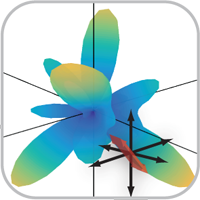5. Extracting matrix elements overview#
In this part, various case studies are presented. To provide context, and ensure that the examples are transparent and can be run directly from the source notebooks, there are also chapters covering the general setup and configuration for the fitting routines. These are, unavoidably, rather technical and code-heavy, so readers only interested in the results should skip these sections. Additionally, these sections may be rather truncated in hard-copy (or PDF) versions of the text, but are available in full in the Quantum Metrology Vol. 3 (HTML version) and source notebooks for readers that wish to perform their own calculations.
The layout for this part is as follows:
Technical introductions
Chapter 6: Basis sets for fitting: introduces methods for setting the basis set used for fitting, defined in terms of symmetrized harmonics.
Chapter 7: General fit setup and numerics: introduces methods for setting up the data to fit, and running fits in various ways.
Case studies
Chapter 8: Case study: Generalised bootstrapping for a homonuclear diatomic scattering system, N_2~(D_{\infty h}): A “simple” 1D case, here the \(D_{\infty h}\) molecular symmetry matches the rotational wavepacket and detection symmetry.
Chapter 9: Case study: Generalised bootstrapping for a linear heteronuclear scattering system, OCS~(C_{\infty v}): A more complicated example. In this case, \(C_{\infty v}\), up-down symmetry is broken in the molecular frame. Fitting for various cases is explored, looking at 1D and 3D alignment.
Chapter 10: Case study: Generalised bootstrapping for a general asymmetric top scattering system, C_2H_4~(D_{2h}): The most general example of an asymmetric top system, in this case \(C_2H_4\) (ethylene), \(C_{2h}\). Again various cases and limitations are examined, for 1D and 3D alignment.
Summary, discussion, conclusions and outlook: Chapter 11 presents a general overview of the case study results - particularly the density matrix and MF-PADs - and conclusions.
5.1. General notes on the case studies#
The case studies presented herein represent various different types (classes or degrees-of-difficulty) of fitting problem. They are intended both to indicate ways to proceed in general, and also aim to address what is, and isn’t, possible in these given cases. The simplest case, \(N_2\), has been well-studied, and reconstruction of radial matrix elements via the bootstrap retrieval protocol has proved successful in a range of valence ionization cases - see Ref. [1] for the initial experimental demonstration, and updated analysis using the Photoelectron Metrology Toolkit [5] in Ref. [3], as well as Chapter 8 herein.
The more complex cases, involving 3D alignment, are new, and very much work-in-progress. The current state-of-the-art is presented herein, but it is of note that these results are provisional, and work is ongoing. In particular, there are a large range of fitting configuration options and parameters which have yet to be explored in these cases, which may significantly improve on the current results in terms of computational effort required, reliability of the fitting protocol, and size of the required dataset. Nonetheless, these new results are interesting and present a stepping-stone for studies on radial matrix elements retrieval in complex systems, and a launching point for similar studies.
Each case study has a setup script and associated data, which was used to create sample data and configure the bootstrap retrieval protocol in each case (the general procedure is outlined in Chapter 7). However, since the fitting is computationally demanding, code execution for large fitting cases is not run upon building the book. Rather the code illustrates the general procedure (for a small batch), and existing fit data files are used if present. Each case study therefore contains an initial setup stage which can be used to run fits, or load existing data, prior to analysis.
In each case study, bootstrap retrieval protocol results sets are analysed at length; for a quick overview of results and fidelities in each case readers may consult the final subsection in each chapter, which provide visual summaries of the results as both density matrices and MF-PADs, and comparison with the reference case. These results form the basis for the summary and discussion in Chapter 11, readers not interested in the full technical details may skip directly to that chapter for general discussion, conclusions and outlook.
Finally, it is of note that - as discussed in the preamble on book versions - output may be significantly truncated in some cases. Readers wishing to obtain all computational details should pull the source notebooks from Quantum Metrology Vol. 3 (Github repo), or consult the online HTML version at Quantum Metrology Vol. 3 (HTML version). Each case study notebook is configured to pull the required data files to setup and run fits from the ePSproc [34] Github repo; data files for the specific example fit results examined in the chapters as published can be obtained separately from the Quantum Metrology Vol. 3 (Github repo).
